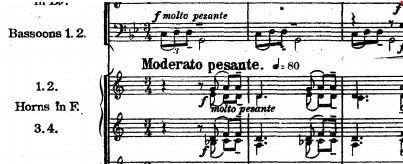
Originally posted to Medium on February 18, 2020.
Thomson delivers a stunning performance of this gut-wrenching work, and David Theodore hits the Oboe Concerto out of the park.
The First World War, during which Vaughan Williams served in many roles but foremost as an ambulance driver in France and Greece, had a massive emotional effect on the composer. He did not complete the Symphony No. 3, ‘Pastoral’, until 1922, four years after the war’s end, but the sounds of war are all throughout this symphony. It is important to know, however, that this symphony, like so many of RVW’s other symphonies, is not programmatic.
The name led to some confusion at the outset. Vaughan Williams wrote a lot of pastoral works, but this symphony doesn’t really fall neatly in with the fantasias or folk song variations or tone poems. It’s less evocative of an English countryside than his other works in that vein and is more a reference to the fields of France where RVW fought in World War 1; he himself said in a letter to his future wife, Ursula Wood, that the Symphony No. 3 is “not really Lambkins frisking at all as most people take for granted”. The famous quote from Peter Warlock about how “it is all just a little too much like a cow looking over a gate” is actually about RVW’s oeuvre as a whole and not the Pastoral, which he personally praised highly and called “the best English orchestral music of this century”.
The symphony opens with an extremely evocative and emotional flute duet underscored a few measures later by a motif in the contrabasses that will be repeated throughout the first movement. This sets the tone for pretty much the entire work. Save for the trio of the third movement, this symphony rarely sees a tempo marking above 100 BPM, if at all. This is going to be an elegaic work right off the bat; like Holst’s Egdon Heath, but less bleak. The flute themes and the short bass motif are the thematic underpinnings of the first movement, evoking a broad, empty landscape. When I listen to the opening of this symphony, I picture vast, rolling fields, with a sky changing colors throughout…but very little, if any, human activity.
The second movement is the heart of this requiem for a useless war. It opens with a horn solo over an F minor chord, and stays very quiet the entire movement. The horn theme is developed by the cello in a long expository package, before the strings settle into a major chord pedal note, and an Eb natural trumpet rises from the distance with a haunting call. This is actually the germ from which this symphony sprouted: RVW had heard a bugler practicing and failing to hit the minor seventh, instead hitting the harmonic seventh. This slightly out of tune approach creates one of the most beautiful solos in a symphony. The horn returns afterwards with the trumpet call, and the cor anglais repeats it, as the movement dies away.
The third movement, marked moderato pesante (heavy walking speed), serves as the symphony’s scherzo; Vaughan Williams described it as a ‘slow dance’. Two themes dominate the shortest movement of the symphony: a heavy eighth-eighth-eighth-dotted quarter pattern, as shown here in the bassoons and horns…

…and this pretty, quick, but still heavy waltz theme in the trumpets and trombones.

These two themes do a lot of interplay before a fugue closes off the movement with the opening theme ‘winning out’, so to speak.
The finale opens with a timpani roll and a wordless soprano solo that just absolutely tears at the heartstrings.

After the soprano, the orchestra begins another broad, sweeping, elegaic passage that sums up the themes from the first two movements. The violins restate the soprano theme in a big moment, then the soprano returns and the symphony ends, like all but two of the nine, with a quiet finish.
The Oboe Concerto is a classic RVW pastoral work. Scored for oboe and a string orchestra, it’s a more appropriate thematic fit with the Symphony No. 5, which was composed immediately prior; parts of the concerto were actually repurposed themes from a scrapped scherzo for the 5th.
Like most concerti, it’s in three movements. They each start with a pentatonic theme over an octave. The three movements are a rondo pastorale, a minuet and musette, and a scherzo. The performance is spectacular. David Theodore does an excellent job.
Up next: The Symphony No. 4 and the Concerto Accademico.